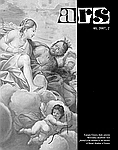
Journal ARS 40 (2007) 2
Introduction: Ivan GERÁT, p. 121
Articles
I.Vladimir P. GOSS: Borders of Art History in a Europe without Borders[Hranice dejín umenia v Európe bez hraníc], pp. 123-128, 4 figs.
Summary
Milena BARTLOVÁ: Creating Borders. The Uses of Art Histories in Central Europe[Vytváření hranic. Užití dějin umění ve střední Evropě], pp. 129-134, 0 figs.
Summary
Ernő MAROSI: Zwischen Kunstgeographie und historischer Geographie. Das Königreich und der Ständestaat Ungarn im Mittelalter[Medzi geografiou umenia a historickou geografiou. Uhorsko ako kráľovstvo a stavovský štát v stredoveku][Between the Geography of Art and Historical Geography. The Kingdom and the Corporate State of Hungary in the Middle Ages], pp. 135-143, 0 figs.
Summary
Ján BAKOŠ: Vienna School Disciples and "The New Tasks" of Art History[Žiaci viedenskej školy a „nové úlohy“ dejín umenia], pp. 145-155, 0 figs.
Summary
II.Zsombor JÉKELY: Regions and Interregional Connections. A Group of Frescoes in the Kingdom of Hungary from around 1420[Regióny a medziregionálne prepojenia. Skupina fresiek na území Uhorského kráľovstva okolo roku 1420], pp. 157-167, 4 figs.
Summary
Marie LIONNET: Borders in Central Europe during the Middle Ages. Some Iconographical Reflections about the Wall Paintings in Hungary[Hranice v strednej Európe počas stredoveku. Niekoľko ikonografických reflexií o nástennom maliarstve v Uhorsku], pp. 169-176, 4 figs.
Summary
Ivan GERÁT: Das Phänomen der Grenze in mittelalterlichen Bildlegenden der Heiligen Elisabeth von Ungarn[Fenomén hraníc v stredovekých obrazových legendách sv. Alžbety Uhorskej][The Phenomenon of Borders in Medieval Pictorial Legends of St. Elizabeth of Hungary], pp. 177-184, 3 figs.
Summary
III.Jeannie J. ŁABNO: Shifting Borders, Conceptual Identities and Cultural Boundaries. Child Commemoration in Renaissance Poland[Posúvanie hraníc, konceptuálne identity a kultúrne obmedzenia. Pomníky a náhrobky detí v renesančnom Poľsku], pp. 185-193, 4 figs.
Summary
Tadeusz J. ŻUCHOWSKI: Kunstgeschichte zwischen Erinnern und Vergessen. Über Forschungen zur Kunst Preußenlandes[Dejiny umenia medzi spomínaním a zabúdaním. O výskume umenia Pruska][Art History between Remembering and Forgetting. About Research on Prussian Art], pp. 195-205, 5 figs.
Summary
Sergiusz MICHALSKI: The Concept of National Art, Problems of Artistic Periphery and Questions of Artistic Exchange in Early Modern Europe[Koncept národného umenia, problémy umeleckej periférie a otázky umeleckej výmeny v Európe obdobia raného novoveku], pp. 207-215, 0 figs.
Summary
IV.Jana ZAPLETALOVÁ: „Die Alpen als Grenze?“ Bemerkungen zum Studium italienischer Freskomaler auf der Wende des 17. und 18. Jahrhunderts in Mähren[„Alpy jako hranice?“ Postřehy ke studiu italských malířů nástěnných maleb přelomu 17. a 18. století na Moravě]["The Alps as a Border?" Remarks on the Study of Italian Wall Painters at the Turn of the 17th and 18th Centuries in Moravia], pp. 217-224, 3 figs.
Summary
Martin MÁDL: Distinguishing – Similarities – Style. Carpoforo and Giacomo Tencalla in Czech Lands[Odlišnosti – Podobnosti – Styl. Carpoforo a Giacomo Tencalla v českých zemích], pp. 225-236, 6 figs.
Summary
Jozef MEDVECKÝ: Zu den Quellen von Tencallas Malstil[K prameňom Tencallovho maliarskeho štýlu][On Sources of Tencalla’s Painting Style], pp. 237-244, 5 figs.
Summary
V.Marina DMITRIEVA: Reinventing the Periphery. The Central East European Contribution to an Art Geographical Discourse[Znovuobjavovanie periférie. Príspevok stredovýchodnej Európy k diskusiám o geografii umenia], pp. 245-252, 4 figs.
Summary
Frank-Thomas ZIEGLER: Mitteleuropa im Spiegel der Kunstgeschichtsschreibung am Brukenthalmuseum 1948 – 2006[Stredná Európa v zrkadle umeleckohistorickej spisby múzea Brukenthal 1948 – 2006][Central Europe in the Mirror of Art Historical Writing at Brukenthal Museum 1948 – 2006], pp. 253-260, 0 figs.
Summary
Joes SEGAL: Ideological Borders and German Art at the Beginning and the End of the Cold War[Ideologické hranice a nemecké umenie na začiatku a na konci studenej vojny], pp. 261-267, 0 figs.
Summary
VI.Tomáš ŠTRAUSS: Gab es eine, oder zwei Avantgarden? (Zur Diskussion um die treibende Kraft der Kunst des 20. Jahrhunderts)[Jedna alebo dve avantgardy? (K diskusii o hybnej sile umenia 20. storočia)][Was There One or Were There Two Avant-gardes? (To the Discussion about the Driving Force of the 20th Century Art)], pp. 269-277, 4 figs.
Summary
Mária ORIŠKOVÁ: Re-writing History, Re-drawing Maps. Central Europe in the Global Story of Art[Prepisovanie histórie, prekresľovanie máp. Stredná Európa v globálnom príbehu umenia], pp. 279-285, 0 figs.
Summary
Andrea DOMESLE: Von der Verschiedenheit künstlerischer Ästhetiken und Bildpolitiken sowie kuratorischer Herangehensweisen in der Gegenwartskunstszene Mitteleuropas[O odlišnosti umeleckých estetík, obrazových politík a kurátorských prístupov na súčasnej umeleckej scéne strednej Európy][On Diversity of Artistic Aesthetics, Image Politics and Curatorial Approaches in the Contemporary Art Scene in Central Europe], pp. 287-292, 7 figs.
Summary